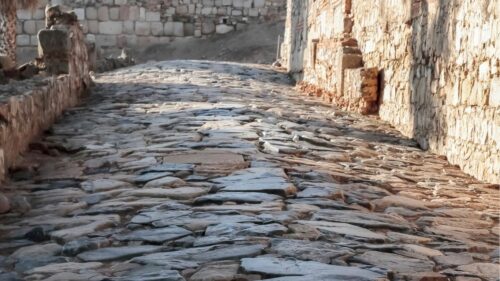
Vehicles need good roads. So does the economy. The Romans, for instance, built roads not just to move armies around their empire but also to open up trade routes.
Roman Roads

The Romans were the first to build roads in the UK. And the main objective was to ensure the roads were as straight as possible. To achieve this, Roman surveyors used a tool known as a groma. The groma was a wooden cross with lead weights hanging from it. When one groma lined up with another groma in the distance, the surveyors had a straight line.
The people who actually built the roads were often Roman soldiers. They began by digging a trench. Into this, they put a layer of stones. This was the road’s foundation. Pebbles, broken stones, sand and cement came next. Then, on top of this, the workers put cement strengthened with broken tiles. Paving stones formed the top layer of the road. The workers cut the stones to fit as neatly as possible.
The other feature of Roman roads was the camber. This allowed water to drain away to channels at either side.
Modern Roads

The Romans didn’t face the regulatory and land problems modern road-builders have to face. In the UK, a road-building project can take seven years from start to finish. Not so long ago, the time frame was 12 – 15 years.
A road design team looks at all possible routes. Subsequent planning issues and environmental considerations may take months to discuss and resolve. Public consultation follows. A government minister then approves a route.
After this, there may be a public enquiry about the road. An independent inspector’s report may accompany the enquiry. Finally, the Secretary of State for Transport makes a decision.
Construction
Construction begins when heavy machinery arrives to clear a path for the road. Bulldozers, earthmovers, diggers, rollers and cranes make up most of the machines.
Just how long this part of the job takes depends on the terrain. There may be a need to prepare the ground for bridges, tunnels and embankments. The road-building team may also have to sink concrete or steel pilings into soft ground to ensure the proposed road has adequate support.
The construction of the road itself follows the principles used by the Romans. The idea is to create a base that inhibits the growth of weeds and provides a surface strong enough to cope with the passage of cars and lorries.
The road-builders, therefore, make the road in a series of layers. The lower layer, often consisting of sand and fine gravel mix, helps suppress plant growth. Gravel and broken rock come next. Each piece of gravel or rock is of a certain approximate size. This way, a roller can compact the layer and bind the pieces together.
Other similar layers may follow using different sizes of gravel and broken rock. Road builders may also use a sand and clay mix, and cement.
The top layer is usually tarmac or asphalt. Tarmac is broken stone mixed with tar; asphalt is bituminous pitch mixed with sand or gravel. The benefit of these surfaces is that they are dust-free. They also give motorists a smooth journey with good road holding.
Disclaimer: The information in the article is for general purpose information only and should not be constituted as legal advice. This article has been produced by a third party and Jardine Motors does not take any responsibility for the completeness, accuracy, or reliability with respect to the website or the information provided. Article last updated March 2016.



